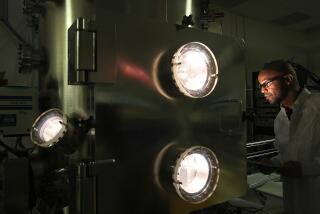U.S. Eases Rules on Civilian Use of Navigation System
The Clinton administration announced a new policy Friday that will dramatically expand civilian use of a military-run, high-tech satellite navigation system--and possibly create tens of thousands of jobs in California.
The new rules governing use of the 24-satellite Global Positioning System will allow motorists, airline pilots, hikers, boaters and others to pinpoint their location using a handheld receiver.
In a White House news conference Friday, Vice President Al Gore said the measures “will help the emerging GPS business explode into an $8-billion industry by the end of the century.”
Rockwell International Corp. in Seal Beach and other California companies account for about 60% of the industry, making hundreds of devices, including traffic control systems for airports.
Executives at a number of California companies said the growth projections seemed a bit optimistic, but they applauded the moves and agreed that their businesses will benefit.
The White House on Friday also pledged to continue providing free access to the system satellites. Southern California companies said they expect to see an increase in overseas sales now that foreign customers have the assurances that the United States will not start charging for access to the signals--or denying access altogether.
The policy change also means that devices now accurate to within 100 meters would be accurate to within about 10 meters.
The technology, used for the first time during the 1991 Persian Gulf War, enables users to determine almost exactly where they are by using a special receiving device that processes signals from the four nearest GPS satellites.
The military version of the system enables commanders to calculate the location of missiles, ships, aircraft, tanks and troops to within 50 feet of their positions, and then flash the geographic coordinates on a screen or electronic map.
Among the more promising commercial applications for the technology, experts say, is the growing use of navigation systems in automobiles. Dashboard models can show a driver precisely where the car is in a city or on a highway and provide directions to one’s destination.
Regional executives said access to the more accurate signals will open new opportunities.
A recent Rand Corp. study urged the military to drop its restrictions and allow all users access to the more accurate signal now used by the armed forces, arguing that it would create a booming business. But military officials were wary about letting down their guard.
Friday’s announcement offered something of a compromise: The military will be allowed to continue blurring the civilian signal as a protective move until it can develop a new kind of safeguard. It then will allow civilians full access to the more-precise signal.
At the same time, if a war breaks out in the interim, the Air Force will be able to ensure the military’s advantage by sending out electronic signals that can degrade the accuracy of civilian receivers that are located anywhere near the battle zone.
In announcing the move, the White House clearly had its eye on California’s huge electoral vote, stressing that the “majority” of the new jobs that are expected to be created most likely would be located in California.
However, industry analysts suggested that only a portion of the 100,000 jobs expected to come from the increased production would involve high-technology slots based in California. Some would be in support industries, making parts or materials and providing services.
Datum Inc., an Irvine company that makes precision timing devices used by telecommunications companies, said the company’s annual sales of $30 million related to GPS could triple by the end of the decade, with a concurrent expansion in employment.
The White House announcement “calms the nerves of the industry around the world,” said Louis Horwitz, chief executive of Datum.






